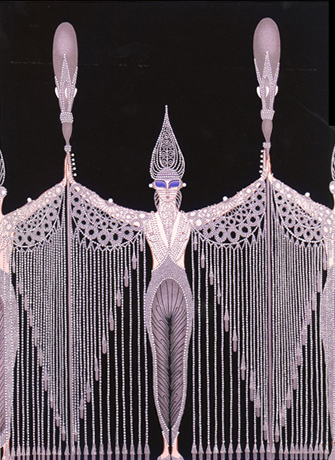
Erté for Harper's Bazaar, November 1933 (via WikiPaintings)
Last week Allen Tan posted on guilty pleasures.
Look: coming clean about a guilty pleasure takes a strange mixture of vulnerability and defensiveness. You’re knowingly putting yourself up for tomato-throwing. And at the same time, it’s confusing to be enjoying this thing in spite of – you really don’t know why! – your otherwise perfect taste.His short essay struck a chord for me. Not only does he quote the key passage in Daniel Mendelsohn's "A Critic's Manifesto," the paragraph that explains how the best criticism works, by explaining the critic's thought process and then leaving it up to you, but I have been meaning to 'fess up in this space for some time.
As my children grow into their own tastes, some quite different from mine, I have started to recall my own early design assertions. I respect my parents the more for supporting my questionable choices. When I declared, at 10, that I was done with Marimekko and wanted instead sheets with blue roses (blue roses!) my mom went with it, going so far as to embroider matching pillowcases with an eyelet ruffle. If you know the adult me or my mother, you know we never ruffle. But she never let on.

Erté, "The Ace of Spades" (via WikiPaintings)
My mother saved the pillowcases and I have them in my linen closet now. They go with nothing in my house, but I am saving them for another little girl who wants her princess fantasy in blue. Maybe it was Pinocchio that inspired me, but just try finding that on the monomanically pink-and-purple mass market.
What came after the blue roses is perhaps more embarrassing: I loved Erté. Or really I should say, I love Erté. Which makes the why of this love worth submitting to Tan's challenge: "Being able to pinpoint what’s good about your guilty pleasures lets you talk about them without feeling ashamed by the bad parts."
Who was Erté? Romain de Tirtoff (initials R.T.), Russian-born, French-trained designer of jewelry, costumes, sets and interiors. His Wikipedia entry offers some good taste connections to Aubrey Beardsley and Paul Poiret. He designed covers for Harper's Bazaar and costumes and sets for what must be a camp classic, The Restless Sex, a film starring Marion Davies and financed by her lover William Randolph Hearst.

Erté, X from "The Alphabet Suite" (via WikiPaintings)
All I knew about Erté was contained between the covers of Dover Publications' Fashion Drawings and Illustrations from Harper's Bazaar, a coloring book. I also had Erté Fashions. Clicking through Erte.com, what do I see that I still admire?
No. 1, the lines. The sinuous, mirrored line that turns up at every scale, from the jewelry to the drop-waist dresses (we'll be seeing a lot of these in Downton Abbey Season 3), from the covers to the movie sets. I remember trying to figure out how the sleeves in "Purity," below, worked as fabric. I remember trying to make my own Erté over and over again, choosing a theme, willing my hand to relax, to become soignée. It never worked. My fashion design remained resolutely two-dimensional (just like a Marimekko).

Erte, "Pearls" (via Erte.com)
No. 2, the themes. I love themes, color schemes, color coding, matchiness. The set of designs for gems, translating pearl into a certain kind of face and dress, intrigued me. It was thorough, in the same way a Wiener Werkstatte interior was thorough, every aspect of pearl considered and incorporated into different sizes of opalescent rounds. The designs retain the same interest as the costumes for the divertissements in The Nutcracker: How will this production interpret Coffee, Tea, Chocolate into a tutu? For the literal-minded child it was a way to see interpretation happening.
No. 3, the monochrome. At the same time I discovered Erté, I also discovered Aubrey Beardsley and Joseh Hoffmann. I was the weird kid who had a Beardsley poster in her (still silver-blue, no ruffles) high school bedroom. I liked to draw patterns. I liked grids. I liked certain kinds of black pens that laid the ink in a pool on the page. I tried calligraphy and Rapidograph drafting pens. The colored Erté doesn't wear as well for me as the graphic, mostly black-and-white designs.

Erté, "Purity" (via Herndon Fine Art)
Are there any other Erté fans out there willing to confess? Do you have another bad taste moment to share? The holidays can seem like a referendum on taste, from the white elephant party to the thrill of finding the perfect gift. You project your likes on to your family members as a consumer, and you also see yourself reflected in the things they choose. Even the cookies you bake. The sadness of the gift card is that it is neutral, a present from the land of "I have no idea what you like." For the designer, that seems a little like saying, "I have no idea who you are."
